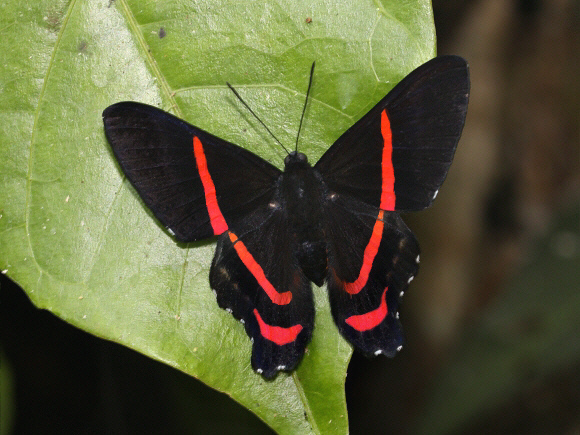 Ancyluris meliboeus eudamon, Tingo Maria, Peru – Adrian Hoskins
Ancyluris meliboeus eudamon, Tingo Maria, Peru – Adrian Hoskins
Introduction
The genusAncyluris comprises of 16 beautiful tailed Riodinids, all confined to the neotropical region. They are closely related to the genus Rhetus, so much so that the females of Ancyluris aristodorus and Rhetus periander are almost indistinguishable, at least from the uppersides.
Males of most Ancyluris species have black uppersides with red bands. In females these bands are broader and paler. In jurgensenii the bands on the female are pure white, and in aristodorus and formosissima they are white in both sexes. Males of all species have a blue iridescence on the underside of the wings.
Ancyluris meliboeus occurs from Colombia to Bolivia.
Habitats
This is a lowland and mid-elevation rainforest species found at altitudes between about 200-1000m.
Lifecycle
I have no data regarding meliboeus but the lifecycle is likely to be similar to that of other Ancyluris species as follows: The eggs are white and highly sculptured. They are laid singly in fissures on the stems or twigs of the foodplants. Egg-laying females tend to settle high up, then walk backwards down the stem, probing with the ovipositor in various places before depositing each egg. The larval foodplants are trees in the families Melastomaceae and Euphorbiaceae. The larvae are gregarious, living in small groups of mixed instars. They are reported to be cannibalistic.
 Ancyluris meliboeus eudamon, Tingo Maria, Peru – Adrian Hoskins
Ancyluris meliboeus eudamon, Tingo Maria, Peru – Adrian Hoskins
Adult behaviour
The males, and less commonly the females, can be found imbibing moisture from bare soil or sandy riverbanks. They are nearly always encountered singly. Both sexes tend to avoid the heat of midday, preferring the cooler conditions of early morning or late afternoon. Even then they are more likely to be found in shady areas than in full sunshine.
